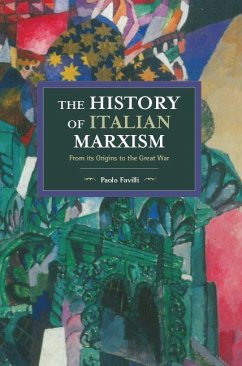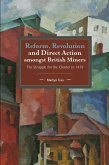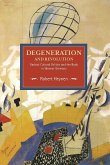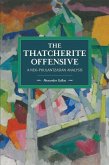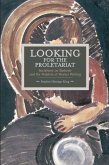- Broschiertes Buch
- Merkliste
- Auf die Merkliste
- Bewerten Bewerten
- Teilen
- Produkt teilen
- Produkterinnerung
- Produkterinnerung
This comprehensive historical survey of Italian Marxism explores the growth of different forms of Marxist culture in the period from the Paris Commune through the First World War. In it, Favilli provides indispensible insight on the impact of various debates?such as those surrounding ?revisionism,' and on the rise of revolutionary syndicalism?on the burgeoning Italian workers' movement.
Andere Kunden interessierten sich auch für
![Reform, Revolution and Direct Action Amongst British Miners Reform, Revolution and Direct Action Amongst British Miners]() Martyn IvesReform, Revolution and Direct Action Amongst British Miners30,99 €
Martyn IvesReform, Revolution and Direct Action Amongst British Miners30,99 €![Degeneration and Revolution Degeneration and Revolution]() Robert HeynenDegeneration and Revolution59,99 €
Robert HeynenDegeneration and Revolution59,99 €![Gramsci's Political Thought Gramsci's Political Thought]() Carlos Nelson CoutinhoGramsci's Political Thought30,99 €
Carlos Nelson CoutinhoGramsci's Political Thought30,99 €![State and Society in Eighteenth-Century France State and Society in Eighteenth-Century France]() Stephen MillerState and Society in Eighteenth-Century France25,99 €
Stephen MillerState and Society in Eighteenth-Century France25,99 €![The Thatcherite Offensive The Thatcherite Offensive]() Alexander GallasThe Thatcherite Offensive25,99 €
Alexander GallasThe Thatcherite Offensive25,99 €![From the Vanguard to the Margins From the Vanguard to the Margins]() Mark PittawayFrom the Vanguard to the Margins38,99 €
Mark PittawayFrom the Vanguard to the Margins38,99 €![Looking for the Proletariat Looking for the Proletariat]() Stephen Hastings-KingLooking for the Proletariat40,99 €
Stephen Hastings-KingLooking for the Proletariat40,99 €-
-
-
This comprehensive historical survey of Italian Marxism explores the growth of different forms of Marxist culture in the period from the Paris Commune through the First World War. In it, Favilli provides indispensible insight on the impact of various debates?such as those surrounding ?revisionism,' and on the rise of revolutionary syndicalism?on the burgeoning Italian workers' movement.
Produktdetails
- Produktdetails
- Verlag: Haymarket Books
- Seitenzahl: 478
- Erscheinungstermin: 26. Dezember 2017
- Englisch
- Abmessung: 229mm x 152mm x 28mm
- Gewicht: 658g
- ISBN-13: 9781608468034
- ISBN-10: 1608468038
- Artikelnr.: 47593559
- Herstellerkennzeichnung
- Libri GmbH
- Europaallee 1
- 36244 Bad Hersfeld
- gpsr@libri.de
- Verlag: Haymarket Books
- Seitenzahl: 478
- Erscheinungstermin: 26. Dezember 2017
- Englisch
- Abmessung: 229mm x 152mm x 28mm
- Gewicht: 658g
- ISBN-13: 9781608468034
- ISBN-10: 1608468038
- Artikelnr.: 47593559
- Herstellerkennzeichnung
- Libri GmbH
- Europaallee 1
- 36244 Bad Hersfeld
- gpsr@libri.de
Paolo Favilli was a professor of Contemporary History and Head of Humanities Department at Genoa University. He is a scholar of the History of Cultures of Socialism. His studies on the history of Marxism include Il Socialismo italiano e la teoria economica di Marx (Bibliopolis, 1980), Marxismo e storia. Saggio sull'innovazione storiografica in Italia (1945-1970) (FrancoAngeli, 2006) and Il Marxismo e le sue storie (FrancoAngeli, 2016).
Preface to the English Edition
Chapter One
The 1860s and 1870s: Marxism rejected, and the humus of Marxism
1.1 The democratic antithesis
1.2. The anarchist antithesis
Chapter Two
The Marxism of the 1880s: the characteristics of a transition
2.1. Socialist culture: sociology
2.2. Socialist culture: political economy
Chapter Three
The Marxism of the 1890s: Foundation - and Orthodoxy?
3.1. The 'Partito marxista'
3.2. Between ideology, science, utopia and religio
3.3. 'The anatomy of civil society'
3.4. The end-of-century Marxist corpus
Chapter Four
Historical Materialism
4.1. What philosophy? What philosophy of history?
4.2. Materialism and a 'philosophy for socialism'
Chapter Five
Marxism and Reformism
5.1. Did reformism have theoretical roots? On the question of
'catastrophism'
5.2. Turati, the 'Marxist' and 'reformist'
5.3. The economic theory of the workers' movement
5.4. The articulations of non-Marxist reformism, the returns of history,
and again on reformist Marxism
Chapter Six
Marxism and Revolutionary Syndicalism
6.1. Did syndicalism have roots in end-of-the-century 'revisionism'?
6.2. Early definitions of a 'Left'-Marxism
6.3. Enrico Leone's and Arturo Labriola's Marx in the 'high' period of
syndicalist theory
6.4. Marxism and elitism in the universe of 'minor' syndicalist
intellectuals
6.5. De hominis dignitate. A workers' syndicalist Marxism? La Scintilla in
Ferrara and Il Martello in Piombino
References
Index
Chapter One
The 1860s and 1870s: Marxism rejected, and the humus of Marxism
1.1 The democratic antithesis
1.2. The anarchist antithesis
Chapter Two
The Marxism of the 1880s: the characteristics of a transition
2.1. Socialist culture: sociology
2.2. Socialist culture: political economy
Chapter Three
The Marxism of the 1890s: Foundation - and Orthodoxy?
3.1. The 'Partito marxista'
3.2. Between ideology, science, utopia and religio
3.3. 'The anatomy of civil society'
3.4. The end-of-century Marxist corpus
Chapter Four
Historical Materialism
4.1. What philosophy? What philosophy of history?
4.2. Materialism and a 'philosophy for socialism'
Chapter Five
Marxism and Reformism
5.1. Did reformism have theoretical roots? On the question of
'catastrophism'
5.2. Turati, the 'Marxist' and 'reformist'
5.3. The economic theory of the workers' movement
5.4. The articulations of non-Marxist reformism, the returns of history,
and again on reformist Marxism
Chapter Six
Marxism and Revolutionary Syndicalism
6.1. Did syndicalism have roots in end-of-the-century 'revisionism'?
6.2. Early definitions of a 'Left'-Marxism
6.3. Enrico Leone's and Arturo Labriola's Marx in the 'high' period of
syndicalist theory
6.4. Marxism and elitism in the universe of 'minor' syndicalist
intellectuals
6.5. De hominis dignitate. A workers' syndicalist Marxism? La Scintilla in
Ferrara and Il Martello in Piombino
References
Index
Preface to the English Edition
Chapter One
The 1860s and 1870s: Marxism rejected, and the humus of Marxism
1.1 The democratic antithesis
1.2. The anarchist antithesis
Chapter Two
The Marxism of the 1880s: the characteristics of a transition
2.1. Socialist culture: sociology
2.2. Socialist culture: political economy
Chapter Three
The Marxism of the 1890s: Foundation - and Orthodoxy?
3.1. The 'Partito marxista'
3.2. Between ideology, science, utopia and religio
3.3. 'The anatomy of civil society'
3.4. The end-of-century Marxist corpus
Chapter Four
Historical Materialism
4.1. What philosophy? What philosophy of history?
4.2. Materialism and a 'philosophy for socialism'
Chapter Five
Marxism and Reformism
5.1. Did reformism have theoretical roots? On the question of
'catastrophism'
5.2. Turati, the 'Marxist' and 'reformist'
5.3. The economic theory of the workers' movement
5.4. The articulations of non-Marxist reformism, the returns of history,
and again on reformist Marxism
Chapter Six
Marxism and Revolutionary Syndicalism
6.1. Did syndicalism have roots in end-of-the-century 'revisionism'?
6.2. Early definitions of a 'Left'-Marxism
6.3. Enrico Leone's and Arturo Labriola's Marx in the 'high' period of
syndicalist theory
6.4. Marxism and elitism in the universe of 'minor' syndicalist
intellectuals
6.5. De hominis dignitate. A workers' syndicalist Marxism? La Scintilla in
Ferrara and Il Martello in Piombino
References
Index
Chapter One
The 1860s and 1870s: Marxism rejected, and the humus of Marxism
1.1 The democratic antithesis
1.2. The anarchist antithesis
Chapter Two
The Marxism of the 1880s: the characteristics of a transition
2.1. Socialist culture: sociology
2.2. Socialist culture: political economy
Chapter Three
The Marxism of the 1890s: Foundation - and Orthodoxy?
3.1. The 'Partito marxista'
3.2. Between ideology, science, utopia and religio
3.3. 'The anatomy of civil society'
3.4. The end-of-century Marxist corpus
Chapter Four
Historical Materialism
4.1. What philosophy? What philosophy of history?
4.2. Materialism and a 'philosophy for socialism'
Chapter Five
Marxism and Reformism
5.1. Did reformism have theoretical roots? On the question of
'catastrophism'
5.2. Turati, the 'Marxist' and 'reformist'
5.3. The economic theory of the workers' movement
5.4. The articulations of non-Marxist reformism, the returns of history,
and again on reformist Marxism
Chapter Six
Marxism and Revolutionary Syndicalism
6.1. Did syndicalism have roots in end-of-the-century 'revisionism'?
6.2. Early definitions of a 'Left'-Marxism
6.3. Enrico Leone's and Arturo Labriola's Marx in the 'high' period of
syndicalist theory
6.4. Marxism and elitism in the universe of 'minor' syndicalist
intellectuals
6.5. De hominis dignitate. A workers' syndicalist Marxism? La Scintilla in
Ferrara and Il Martello in Piombino
References
Index

